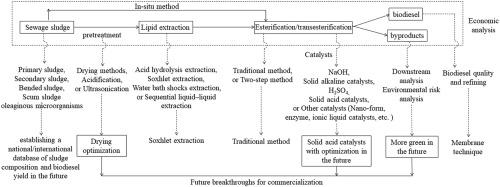Renewable and Sustainable Energy Reviews ( IF 15.9 ) Pub Date : 2020-08-20 , DOI: 10.1016/j.rser.2020.110260 Xiaoyan Liu , Fenfen Zhu , Rongyan Zhang , Luyao Zhao , Juanjuan Qi

|
Treatments for and methods of disposing of municipal sewage sludge have a limited ability to produce high-value products. The number of studies on using sludge for energy recovery—including those that use sludge lipids to produce biodiesel—has increased considerably. This study reviews and compares methods for all steps in the process of producing biodiesel from municipal wastewater sludge, including sludge pretreatment and lipid extraction methods, catalyst selection, and byproduct generation, and its economics analysis. Sludge drying by heat maybe the most efficient method but cost a lot, and drying by vacuum and chemicals are expected for future advancement. In the lipid extraction, organic solvents are costly and unfavorable to the environment. Therefore, alternative extractant that are more efficient, and environmentally friendly are of potential use but still need price reduction. In terms of catalysts, H2SO4 is an efficient and cheap catalyst in practical use but consumes a lot in operation. Solid acid catalysts are promising alternatives because of cost saving and environmental benign. Some new catalysts such as ionic liquid and enzymes are just promising in the much further future. The byproducts of different biodiesel production processes have been classified and been made downstream and environmental risk analysis. The optimization and greenness of catalysts and byproducts promote the commercialization of sewage sludge for biodiesel production. In addition, biodiesel refining by membrane technique is promising.
中文翻译:

利用城市污水污泥生产生物柴油的最新进展
处理城市污水污泥的方法和方法生产高价值产品的能力有限。使用污泥进行能量回收的研究数量(包括使用污泥脂质生产生物柴油的研究)已大大增加。这项研究回顾并比较了从城市废水污泥生产生物柴油过程中所有步骤的方法,包括污泥预处理和脂质提取方法,催化剂选择和副产物生成及其经济分析。通过加热干燥污泥可能是最有效的方法,但是成本很高,并且通过真空干燥和化学药品干燥有望在未来得到发展。在脂质提取中,有机溶剂昂贵且对环境不利。因此,更有效的替代萃取剂 环保的材料有潜在用途,但仍需要降低价格。就催化剂而言,H2 SO 4在实际使用中是一种高效且廉价的催化剂,但在运行中消耗很多。固体酸催化剂由于节省成本和对环境有益而成为有前途的替代品。一些新的催化剂,例如离子液体和酶,在更远的将来才有希望。对不同生物柴油生产过程的副产物进行了分类,并进行了下游和环境风险分析。催化剂和副产物的优化和绿色环保促进了用于生物柴油生产的污泥的商业化。另外,通过膜技术精制生物柴油是有前途的。



























 京公网安备 11010802027423号
京公网安备 11010802027423号